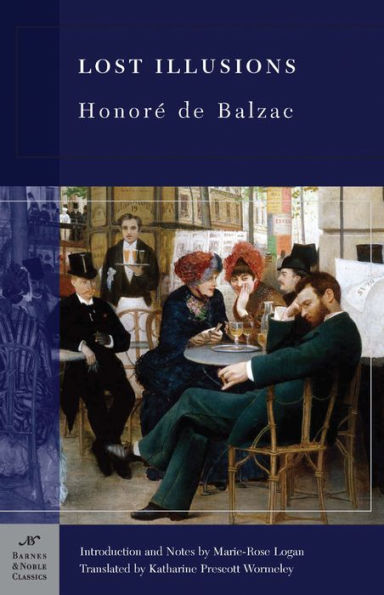Read an Excerpt
From Marie-Rose Logan’s Introduction to Lost Illusions
Between 1789 and 1830 France went through dramatic political upheavals that shaped the life of Balzac and in turn reverberated in the characters he created, especially those in Lost Illusions. The novel begins in 1819 with the return of David Séchard from Paris to Angoulême, where he is to take over his father’s printing house. The intellectual gap between father and son, if shocking, results from the many social upheavals that took place in the wake of the Revolution. During the period of the National Convention (a legislative body that governed France from September 1792 to October 1795, Old Séchard had been able to buy the printing house from the widow of his boss, the master-printer. There were no children who could take over the business. Furthermore, most workmen in L’Houmeau had been drafted in the war France was waging—amidst the Revolution—against Prussia. Séchard, who had escaped the draft, was the only workman left in the shop; the printing house was about to shut down. So representatives of the people, eager to promote the new egalitarian regime, bestowed the title of master-printer on the shrewd, but illiterate Séchard. Citizen Séchard, in turn, took advantage of the fact that many members of the aristocracy and the clergy needed an alibi to avoid the guillotine: The Comte de Maucombe did the typesetting and corrected the proofs of the revolutionary decrees that came out of the Séchard printing house, and Séchard also added to his staff a priest who had not taken the oath that the Convention required from members of the clergy who wished to avoid the scaffold. In the meantime, the newly minted master-printer was able to send his son to a Lyceum where the latter received an education that until the reign of Napoleon had been available only to members of the upper class. Then David went “up”—as the French expression goes—to Paris for an apprenticeship with Firmin Didot, the best and most fashionable printer in Paris (see endnote 2 to Part I).
In Part II of Lost Illusions, the journalist Emile Blondet declares that “for twenty years” France has undergone four dramas “the Revolution, the Directory, the Empire, and the Restoration.” Born during the Directory—about six months before Bonaparte’s 1799 coup d’état—Balzac lived through three of these dramas. He grew up during the Consulate and the Empire. Balzac was an adolescent when the monarchy was restored in 1814. The reign of Louis XVIII, followed by that of Charles X, would last until a three-day revolution in July 1830 placed Louis-Philippe d’Orléans, the “citizen king,” on the throne; he held it until ousted in 1848 by the future Napoleon III.
During 1830s Balzac became a prolific and known writer, following a period in which he had nurtured business ambitions. At one point he owned a printing house, a foundry, and a publishing house, ventures that ended in bankruptcy in part because Balzac always spent far more than he earned. Much like Lucien de Rubempré, Balzac led the peripatetic life of a social gadfly. During those years he published under various pseudonyms La dernière fée (1823; TheLast Fairy), Annette et le criminel (1824; Annette and the Criminal), and other minor works. By 1828 Balzac had moved several times within Paris because his creditors were constantly on his heels. Finally he fled to the house of his friend Général de Pommereul in Brittany. There he composed Les Chouans, a historical novel about the guerrilla warfare that took place in 1799 between royalists and republicans. This novel, published in 1829 under the name Balzac, earned him some recognition. In the same year the publication of Physiologie du Mariage: Essais de philosophie (Physiology of Marriage: Essays in Eclectic Philosophy) brought him real success and opened the doors of the literary salons of Madame de Récamier and Madame Girardin, where he was introduced to Chateaubriand, Victor Hugo, Alfred de Vigny, Alexandre Dumas, and the painter Delacroix. From then on Balzac juggled writing—he sometimes wrote for sixteen hours in one sitting—with a very busy social life.
In Lost Illusions, more than in any other work Balzac, explores the socio-economic challenges that took place during the Restoration in Paris and in the provinces. Balzac was equally fascinated with the two worlds, yet he usually kept them apart. For instance, The Vicar of Tours (1832), Eugénie Grandet (1833), and The Lily of the Valley (1836) are entirely set in the provinces, whereas Sarrasine (1831), Père Goriot (1835), and A Harlot High and Low take place in Paris. When he undertook to classify his works for publication in the monumental Human Comedy, Balzac grouped the first three under the heading “Scenes from Provincial Life,” and the second group as “Scenes from Parisian Life.” One of the reasons Lost Illusions is such a tour de force is the subtle permeability Balzac establishes between Paris and the province. Balzac usually characterizes provincial life as monotonous, petty, and boring. In contrast, Parisian life translates into mobility, passion, and genius. Money, greed, and social prestige are driving forces, but they do not operate in the same way in the two places.




